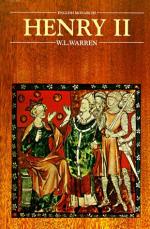The revolt of 1173-74 was the final ruin of the old party of the Norman baronage. The Earl of Chester got back his lands, but lost his castles, and was sent out of the way to the Irish war; he died before the king in 1181. Leicester humbly admitted “that he and all his holdings were at the mercy of the king,” and Henry “restored to him Leicester, and the forest which by common oath of the country had been sworn to belong to the king’s own domain, for he knew that this had been done for envy, and also because it was known that the king hated the earl;” but Henry had a long memory, and the walls of Leicester were in course of time thrown down and its fortifications levelled. The Bishop of Durham had to pay 200 marks of silver for the king’s pardon, and give up Durham Castle. At the death of Hugh Bigod in 1177 Henry seized the earl’s treasure. The Earls of Clare and Gloucester died within two years, and the king’s son John was made Gloucester’s heir. The rebel Count of Aumale died in 1179, and his heiress married the faithful Earl of Essex, who took the title of Aumale with all the lands on both sides of the water. In 1186 Roger Mowbray went on crusade. The king took into his own hands all castles, even those of “his most familiar friend,” the justiciar De Lucy. The work of dismantling dangerous fortresses which he had begun twenty years before was at last completed, and no armed revolt of the feudal baronage was ever again possible in England.
But the rebellion had wakened in the king’s mind a deep alarm, which showed itself in a new severity of temper. Famine and plague had fallen on the country; the treasury was well nigh empty; law and order were endangered. Henry hastened to return as soon as his foreign campaign was over, and in May 1175 “the two kings of England, whom a year before the breadth of the kingdom could not contain, now crossed in one ship, sat at one table, and slept in one bed.” In token of reconciliation with the Church they attended a synod at Westminster, and went together on solemn pilgrimage to the martyr’s tomb. Then they made a complete visitation of the whole kingdom. Starting from Reading on the 1st of June, they went by Oxford to Gloucester, then along the Welsh border to Shrewsbury, through the midland counties by Lichfield and Nottingham to York, and then back to London, having spent on their journey two months and a few days; and in autumn they made a progress through the south-western provinces. At every halt some weighty business was taken in hand. The Church was made to feel anew the royal power. Twelve of the great abbeys were now without heads, and the king, justly fearing lest the monks should elect abbots from their own body, “and thus the royal authority should be shaken, and they should follow another guidance than his own,” sent orders that on a certain day chosen men should be sent to elect acceptable prelates at his court and in his presence. The safety of the Welsh marches was




